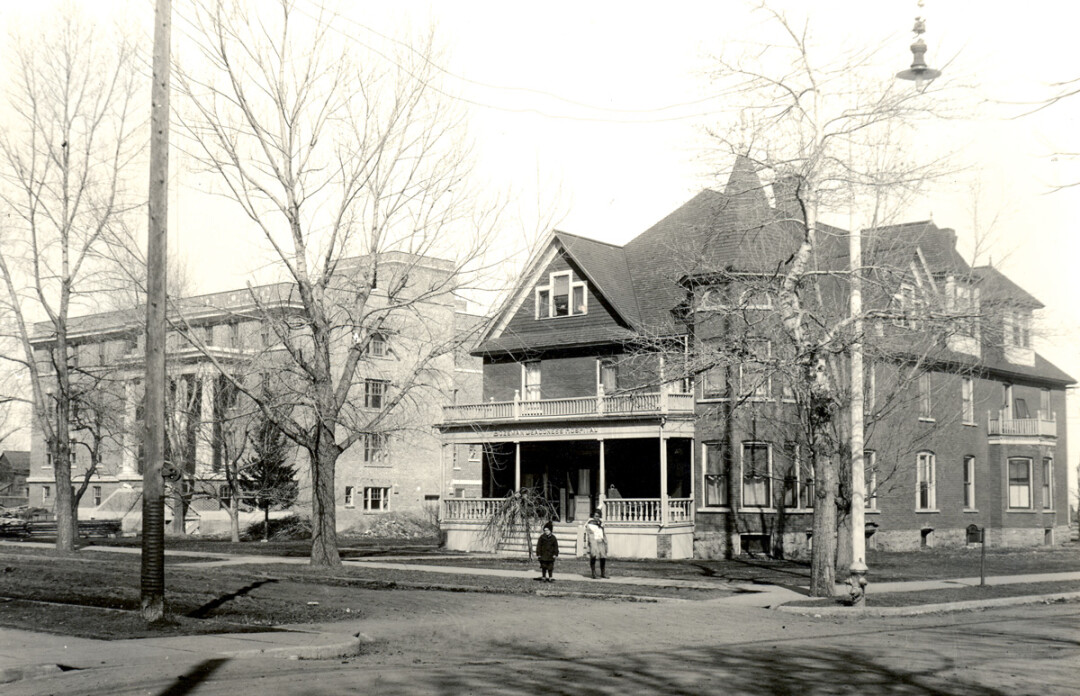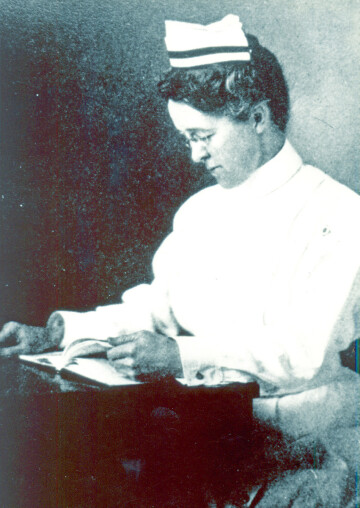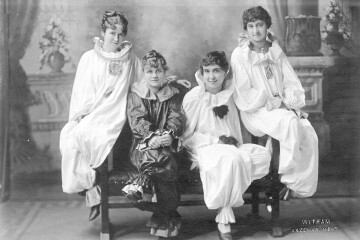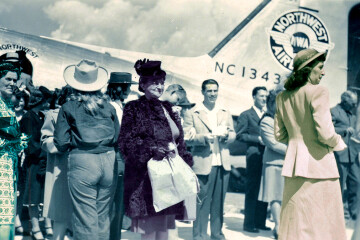Bozeman’s Medical Heroes

In the late 1860s, only a handful of doctors lived in the Gallatin Valley, and most split their time between practicing medicine and other more lucrative careers. Today, our community supports a large regional hospital that employs hundreds of medical professionals. Recent current events encourage us all to think of the dedicated medical staff who daily put their health at risk to care for the sick. In honor of our local medical professionals and community volunteers, here is a brief history of medicine in Bozeman that highlights a few hometown heroes from the past.
Like most frontier towns in the 1860s and 1870s, Bozeman had few options when it came to medical care, and home remedies and “cure-all” pills filled in the gaps. Fort Ellis, established just a couple miles east of Bozeman in 1867, did attract a few medical personnel to the area. One of these doctors was Dr. Robert M. Whitefoot, who eventually settled in Bozeman. After beginning his career in the Gallatin Valley caring for soldiers, he later set up a medical practice in town and catered to local civilians until he passed away in 1906.
Many early physicians worked other careers on the side or held civic leadership positions. Dr. George Washington Monroe was a Virginian by birth and arrived in Bozeman in the early 1870s. Besides practicing medicine, he served as Gallatin County Superintendent of Schools from 1877-1882, and Bozeman’s mayor from 1886 to 1887. Dr. Monroe later relocated to Butte where he died in 1912. Dr. Achilles Lamme established himself in the mercantile trade after he arrived in Bozeman in 1865. His store, A. Lamme & Co., was located on the north side of Main Street between Tracy and Black Avenues. Because of the shortage of other qualified physicians in the area, Dr. Lamme did lend his services from time to time to area residents. Interestingly, Lamme Street, which was named for Dr. Achilles Lamme, later became the location of Bozeman’s first hospital.
In 1892, the Bozeman Polk city directory listed eight physicians in town but still no hospital, and Bozeman’s population was booming. Several factors contributed to this growth, including the arrival of the Northern Pacific railroad in 1883, Montana’s admission as the 41st state in 1889, and the creation of Montana Agricultural College (now MSU) in 1893. The time had come for Bozeman to have its first formal hospital, and Dr. Henry Foster was the right man to take charge.
Minnesota-born Dr. Henry Foster arrived in Bozeman in 1882 at the young age of twenty-four, already a trained surgeon. Cesarean sections were virtually unheard of in Montana in the 1890s, but the confident Dr. Foster performed one safely in Bozeman in 1893, likely the first such procedure in the state. After a second successful C-Section three years later, Foster quickly gained notoriety in his field. Accounts of the procedures in medical journals amazed eastern practitioners, who could not imagine performing such a surgery away from modern facilities. Dr. Foster’s small practice began bursting at the seams as new patients from across the region sought his care.
In 1896, Foster’s success allowed him to construct a sophisticated 20-bed hospital on the northwest corner of Lamme and Tracy. The building boasted hot-water heat and electricity, colorful wall and ceiling frescoes, and an operating room. Originally named Bozeman Sanitarium for Women, the word “Women” was soon dropped from the name in order to welcome male patients and children. The Bozeman Sanitarium was heavily used, and Dr. Foster was able to build an addition after only a few years in business.
Tragically, Dr. Foster died in his mid-40s in 1902. Dr. James Franklin Blair briefly took over the operation of the Bozeman Sanitarium and changed the name to the Blair Sanitarium. Financial difficulties led him to lease the hospital to the Deaconesses of the Methodist Church in Montana. The Methodist Deaconesses partnered with the community, and thanks in part to money raised by local citizens, the hospital was purchased in 1912 and renamed Bozeman Deaconess Hospital.
The Deaconesses, single women trained as nurses working for the Methodist Church, took over hospital operations in the early 20th century. Deaconess nurses made a huge impact on local medical care, even though some, like Miss E. August Ariss, were only in Bozeman for a short time. In the early 1900s, Miss Ariss left Toronto to work in a Methodist mission in Montana and soon found herself the superintendent of the Deaconess Hospital in Great Falls. She came to Bozeman in 1911 and used her management skills to transform the old financially struggling sanitarium into a modern and efficient hospital. As superintendent, she also established a nursing school on site that provided both instruction and boarding. E. Augusta Ariss left Bozeman in 1914, but the nursing school and hospital continued to grow.
In 1918, at the close of World War I, the devastating Spanish Influenza pandemic hit Bozeman. Like today, schools closed, public gatherings were canceled, and quarantine measures were put into place. The empty Gallatin County High School on Main Street and several buildings on the Montana State College campus were converted into makeshift hospitals. Also like today, doctors and nurses worked tirelessly to care for victims of the virus. On campus, young female students like Gudruda Berg in Hamilton Hall carried on their studies as best they could while saving out time each day to make face masks and sputum cups to help curb the spread of the flu. Gudruda Berg made it through the Spanish Flu pandemic unscathed, married, had a family, and later taught her children how to make paper drinking cups—a skill she remembered from her 1918 quarantine at MSC (for her full story see “The Pandemic of 1918 Still Affects Me and I Didn’t Even Exist Then,” by Jim Sargent with Linda Sargent Wood, Gallatin History Quarterly, Vol. 41 No. 4).
Fortunately, the Spanish Influenza pandemic slowly subsided and life returned to normal. In 1920, a brand-new 50-bed hospital designed by local architect Fred Willson was constructed on Lamme Street, adjacent to Dr. Foster’s old Bozeman Sanitarium. Repurposed as a nursing residence and training school, the old sanitarium was utilized until 1952. In the mid-1940s, hospital management transferred away from the Deaconesses, but the hospital continued to grow. A new west wing was constructed and in the 1950s and 1960s, new departments were added, including radiology, physical therapy, an intensive care unit, and a medical laboratory.
Bozeman’s first pathologist, Dr. Volney Steele, worked out of this laboratory on the top floor of the Bozeman Deaconess Hospital on Lamme Street. The son of a physician, Volney Steele grew up in Arkansas and after graduating from medical school, served in the Navy during World War II. Following a brief stint at a naval hospital in Jacksonville, Florida, during the Korean War and two years in Colorado, he returned to school to pursue specialized training in pathology, and jumped at the chance to complete a residency at a hospital near the Panama Canal.
In 1959, a doctor in Butte, Montana, urged Volney to move north and become his partner. During a preliminary visit to Butte, Dr. Steele befriended several Bozeman doctors who convinced him to move to the Gallatin Valley instead, much to the Butte doctor’s disappointment. Dr. Steele spent the rest of his professional career in Bozeman and was known for keeping a box of donuts in his lab. The pastries drew his colleagues through his door for visits as they made their hospital rounds. Volney Steele passed away in Bozeman in 2015.
As the 20th century progressed, Bozeman’s medical center began to outgrow the downtown area. In 1956, forward-thinking hospital administrators purchased land on the eastern edge of Bozeman, just south of Sunset Hills Cemetery. This was fortunate, because over the next three decades Bozeman’s population continued to grow and by the early 1980s the Bozeman Deaconess Hospital on Lamme Street was too small. The new Bozeman Deaconess Hospital on Highland Blvd. was constructed in 1986 and has only continued to expand over the last thirty years.
Bozeman’s history is full of champions like Dr. Henry Foster, E. Augusta Ariss, Gudruda Berg and Dr. Volney Steele. Their contributions to local healthcare – accomplishments big and small – were all important. Let’s send out a big “thank you” to the doctors, nurses, lab techs, hospital staff and community volunteers who stand on the shoulders of our past medical heroes. 





